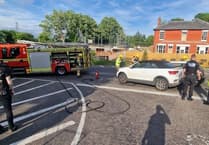THE all-party parliamentary group on general aviation says it intends to investigate the way that airspace changes are processed by the Civil Aviation Authority (CAA) in the UK in the wake of a controversial decision to grant controlled zones to a large swathe of South East airspace around TAG Farnborough Airport.
Locally sensitive because low-flying jets could make Alton and its villages a “hotspot” of noise and air pollution, last week’s decision by the CAA to approve the airspace change proposal by TAG Farnborough has been met with “extreme disappointment” by Lasham Gliding Society whose members believe the changes could also “threaten the safety of general aviation”.
Now in the middle of its hugely popular bi-annual airshow, TAG Farnborough has, of course, welcomed last week’s announcement.
“The proposed airspace design will offer all airspace users predictability and consistency of operations, leading to further reductions in noise and CO2 (carbon dioxide) emissions,” a spokesman said.
“This will result in more precise and efficient inbound and outbound flight paths, leading to fewer flights at low altitudes as arriving aircraft will remain higher for longer and departing aircraft will climb higher more quickly, as well as a net reduction in people overflown.”
In a statement, the CAA has confirmed the decision to “largely approve” the airport’s request for the introduction of class D (restricted) airspace in its surrounding area, but “subject to some significant concessions to the general aviation community”.
And the statement continued: “Given the increase in business aviation at Farnborough Airport, there was a material safety case for introducing controlled airspace around the airport to create a known traffic environment.”
However, to accommodate the needs of other airspace users, two airspace blocks to the south-west and south of the airport will be classified as class E, not class D. These blocks are to be known as transponder mandatory zones, allowing access for aircraft without the need for air traffic control clearance - providing they are equipped with a transponder (a device for receiving a radio signal and automatically transmitting a different signal) or have an arrangement with Farnborough air traffic control.
TAG will also be required to collaborate on reasonable access arrangements for gliders in three further class D airspace blocks in the vicinity of RAF Odiham and Lasham Airfield.
Commenting on the decision, Jon Round, head of airspace at the CAA, said: “This has been a long and complicated application and we respect the concerns of some sections of the general aviation community who have opposed it. However, we believe there is a very real safety case for creating a known traffic environment in the vicinity of Farnborough Airport to protect all airspace users.”
The CAA said that the new airspace, which will become operational in 2019, is the minimum necessary to contain the international requirements for new performance-based navigation flight procedures being introduced at Farnborough Airport.
Reaffirming its commitment to the “safe, fair and equitable use of UK airspace”, the CAA further stated that “where the establishment of controlled airspace is necessary for aviation safety, access for private pilots will always be taken into account and in some cases, such as this, the development of new lost cost, hi-tech conspicuity devices will support this”.
But Lasham Gliding Society is not on board. Having spent more than three years discussing the TAG proposals, and seeking a way forward for all concerned, including a compromise proposal, as requested by the CAA, professional pilot Peter Reading said the gliding society was now seeking legal advice on what to do next.
In a statement, Lasham Gliding Society said that in its view the proposal “does not address the safety concerns raised by Lasham and other general aviation stakeholders”.
Mr Reading said: “This is the aeronautical equivalent of building a brick wall 45 seconds flying time from Lasham, then putting a motorway over the top, as it creates a choke point funnelling traffic through the already busy area in the vicinity of Lasham.
“The decision claims to maintain the level of safety for Farnborough traffic but it will be considerably more dangerous for others just outside the controlled airspace. No data has ever been provided by the CAA to support the assertions made in the decision despite repeated requests.”
Regarding this airspace change as a test case, the all-party parliamentary group on general aviation points out that currently the CAA and airspace change sponsors (usually airports) make changes under a set of rules devised by the CAA, with little ministerial guidance, and it wants that to change.
Commenting on the TAG Farnborough decision, MP Grant Shapps, chairman of the 170-strong all-party group, said: “We start from a position that says airspace belongs to everyone. We entirely accept that there will be cases for implementing controlled airspace, but we are concerned that the current procedure circumvents parliamentary and ministerial oversight both in terms of policy direction and decision-making.”
Because the decision will impact significantly on general aviation airspace users, the investigation will also look into the future introduction of compensation arrangements, similar to the Section 106 agreement in the planning process, as well as the introduction of a “democratic filter”.





Comments
This article has no comments yet. Be the first to leave a comment.